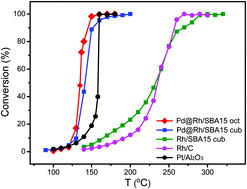Here we report a facile synthesis of Pd@Rh core–shell nanocrystals with octahedral and cubic shapes. Under optimized conditions, Rh atoms can be deposited on Pd octahedral or cubic seeds in a layer-by-layer fashion to generate core–shell nanocrystals with a well-controlled shape. We then use CO oxidation as a probe to evaluate the catalytic performance of the core–shell nanocrystals with reference to a number of commercial catalysts. When supported on mesoporous silica, both the octahedral and cubic Pd@Rh nanocrystals show CO to CO2 conversion levels similar to that of a commercial Pt/Al2O3 catalyst while the two catalysts based on pure Rh (commercial Rh/C and Rh nanocubes/silica) needed much higher temperatures to reach the same level of conversion. In terms of ignition temperature, the Rh nanocubes show a value of 260 °C while those of the octahedral and cubic Pd@Rh nanocrystals are as low as 140 and 150 °C, respectively. Our results suggest that there is no significant difference between the octahedral and cubic Pd@Rh nanocrystals in terms of performance towards CO oxidation while both of them are advantageous over Rh nanocubes or Rh/C.
